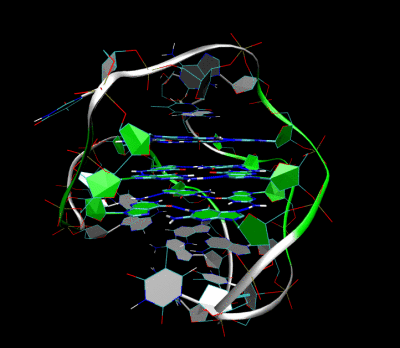 |
| Pictured: DNA (not really) |
DNA, in its most basic form, is a long strand made up of the bases adenine, thymine, guanine and cytosine, which are typically represented by A,T,G and C. The strand exists in a double helix structure, where each base is paired to its appropriate match (A to T and C to G).
 |
| Here, we see the DNA base pairs, as well as DNA in its natural form, the double helix. |
When the cell must divide, the DNA is peeled apart, and appropriate base pairs are added to either strand. The result is two identical strands of DNA, which are then separated into two new daughter cells. Perfect.
Except... that's not quite the case. Unfortunately, the DNA replication process isn't quite perfect. Every time the DNA divides and is replicated, a few bases are lost off the end of the strand. That's where telomeres come in.
 |
| Doesn't look like much, but these things keep your DNA safe |
Telomeres are lengths of repetitive DNA that have no function other than to be missed out in replication. They do not code for anything when the DNA is read by the ribosome, so if they are not present, then the cell, and by extension the body, can still function normally.
What the telomeres do provide is a sort of bumper zone for the DNA replication failure. As previously stated, the replication chops a few bases off the end of the strand each time. If the bases being missed coded for important proteins, then missing them could potentially kill the cell. If this happened in all the cells of the body, then it would barely be able to support itself. However, removal of sections of the telomeres causes absolutely no negative effects towards the cell. If the bases that are missed are from the telomere, the cell can continue functioning as per normal.
So how does this cause ageing? Well, the telomeres are absolutely fine being missed out during every division, but unfortunately, there's only so many times this can happen. Over time, the telomeres are degraded, until eventually there is nothing left. At this point, the bases missed off by replication ARE crucial to the cell. The cells then fail to divide, and slowly, the rate of cell death rises. How does this manifest itself? In the form of ageing. Most interestingly is the time it takes for the telomeres to be entirely degraded. It's around 25 to 30 years, which around the same time ageing begins in the human body.
So there we are. Your DNA is like a shoelace, and the telomeres are like the aglets. When they are there, they keep everything in check.When they are removed, everything starts unravelling.
And then your shoe falls off.
No comments:
Post a Comment